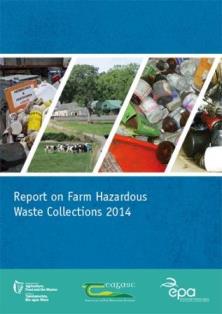Farm Hazardous Waste Report 2014
Summary: The EPA, Teagasc, the Department of Agriculture, Food and the Marine (DAFM), 10 local authorities, WEEE Ireland, European Recycling Platform (ERP), and RILTA Environmental Ltd collaborated in 2014 in a joint initiative to facilitate the collection, recover and disposal of hazardous waste from farms.

The Environmental Protection Agency (EPA); Teagasc; the Department of Agriculture, Food and the Marine (DAFM); local authorities in Kilkenny, Offaly, Dublin, Cavan, Donegal, Mayo, Waterford, Cork, Limerick and Wexford; WEEE Ireland; European Recycling Platform (ERP); and RILTA Environmental Ltd collaborated in 2014 in a joint initiative to facilitate the collection, recovery and disposal of hazardous waste from farms.
In 2014, 10 collection centres were operated, with over 2000 farmers using the centres to dispose of their farm hazardous wastes in a manner that protects human health, livestock and the environment. A total of 170 tonnes of farm hazardous waste, 55 tonnes of waste electrical and electronic equipment (WEEE) and 22 tonnes of batteries were collected. The average weight per farmer was 91 kg of hazardous waste and 53 kg of WEEE and batteries.
The main hazardous waste types brought by the farmers on a weight basis to the centres were:
- Waste engine and hydraulic oil - 102 tonnes
- Pesticides ( including POPs) – 18 tonnes
- Contaminated empty containers – 1 4 tonnes
- Waste paint ( solvent, lead and water based) – 12 tonnes
- Veterinary medicine wastes – 11 tonnes
- Oil filters – 7 tonnesCorrosives ( acids, bases) – 4 tonnes
- Other hazardous wastes (biocides, aerosols, adhesives, coolants, creosote etc.) – 6 tonnes
The 2014 hazardous waste collections follow on from the very successful campaign which operated in 2013, details of which is available in the following report: Pilot Farm Hazardous Waste Bring Centres in 2013 (Interim report). These collections confirm that there are substantial quantities of hazardous wastes on farms (both legacy and current) which pose a potential risk to farmers, their livestock and the environment. Farmers have also demonstrated that they want to manage these wastes in an appropriate manner as evident by their participation and willingness to contribute financially to the safe recovery and disposal of these wastes.
The collections also support many existing national legislative and policy requirements and ambitions including, the National Waste Prevention Programme, the National Hazardous Waste Management Plan, the Water Framework Directive, the Stockholm Convention on Persistent Organic Pollutants (POPs), Pesticide legislation, Food Harvest 2020, Bord Bia Quality Assurance Schemes and Smart Farming, a resource efficiency initiative (www.smartfarming.ie).
The combined collections in 2013 and 2014 probably represent the largest ever voluntary bulk removal of highly toxic pollutants out of the Irish environment in such a concentrated period of time. The farm hazardous waste campaign has clearly identified the need for a suitable and affordable national scheme for the management of farm hazardous waste. At the moment government departments and agencies (DECLG, EPA, DAFM, Teagasc) are working together to formalise a national scheme for the collection of farm hazardous waste, however this will take a bit of time. In the interim period, and until a permanent national scheme is established (most likely by 2017), it is intended that the farm hazardous wastes collections will continue to be operated in 2015 and 2016.
https://www.epa.ie/media/epa-2020/publications/compliance-amp-enforcement/waste/Farm_Hazardous_Waste_report_cover2.jpg